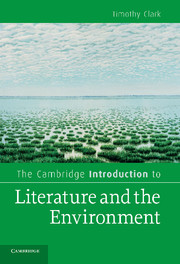Book contents
- Frontmatter
- Contents
- List of illustrations
- Preface
- Acknowledgements
- Introduction
- Romantic and anti-romantic
- The boundaries of the political
- Science and the struggle for intellectual authority
- The animal mirror
- Chapter 18 Ethics and the non-human animal
- Chapter 19 Anthropomorphism
- Chapter 20 The future of ecocriticism
- Notes
- Further reading
- Index
- Cambridge Introductions to …
Chapter 20 - The future of ecocriticism
Published online by Cambridge University Press: 05 June 2012
- Frontmatter
- Contents
- List of illustrations
- Preface
- Acknowledgements
- Introduction
- Romantic and anti-romantic
- The boundaries of the political
- Science and the struggle for intellectual authority
- The animal mirror
- Chapter 18 Ethics and the non-human animal
- Chapter 19 Anthropomorphism
- Chapter 20 The future of ecocriticism
- Notes
- Further reading
- Index
- Cambridge Introductions to …
Summary
Since it emerged as a self-conscious movement in the 1990s, ecocriticism has transformed itself from a relatively minor body of work characterised mainly by a close relationship to environmental non-fiction, into a plural school with practitioners across the world, both vastly extending its scope and reconsidering its basic concepts.
Looking over the body of environmental literary criticism as a whole, it is still hard to see any specific ‘ecocritical’ method emerging. Instead, the issues are taking the more challenging form of a general uncertainty and revision of intellectual boundaries. The limitations as well as the excitement of ecocritical work to date may reflect the fact that environmental questions are not just a matter of aesthetics, politics, poetics or ethics, but can affect certain ground rules as to what these things mean. Who would have thought, even recently, that flicking off a light switch could become part of a new virtue ethic?
Above all, the crucial term nature is being questioned in some senses and reaffirmed in others. Nature and the natural cannot now convincingly function as self-validating norms underwriting a romantic, anti-modern politics or as the self-evidently desirable other of the artificial or the cultural. Instead, environmental criticism is increasingly coming to affirm a more explicitly amoral ‘nature’, in the sense of the wild, physis, coyote, that which is not a matter of human control or calculation.
- Type
- Chapter
- Information
- The Cambridge Introduction to Literature and the Environment , pp. 202 - 203Publisher: Cambridge University PressPrint publication year: 2011

